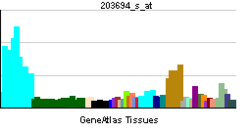- DHX16
-
DEAH (Asp-Glu-Ala-His) box polypeptide 16 Identifiers Symbols DHX16; DBP2; DDX16; PRO2014; PRP8; PRPF2; Prp2 External IDs OMIM: 603405 MGI: 1916442 HomoloGene: 2658 GeneCards: DHX16 Gene EC number 3.6.4.13 Gene Ontology Molecular function • nucleotide binding
• nucleic acid binding
• RNA helicase activity
• ATP binding
• ATP-dependent helicase activity
• hydrolase activityCellular component • nucleus Biological process • mRNA processing
• RNA splicingSources: Amigo / QuickGO RNA expression pattern 
More reference expression data Orthologs Species Human Mouse Entrez 8449 69192 Ensembl ENSG00000204560 ENSMUSG00000024422 UniProt O60231 n/a RefSeq (mRNA) NM_001164239.1 NM_026987.2 RefSeq (protein) NP_001157711.1 NP_081263.2 Location (UCSC) Chr 6:
30.73 – 30.75 MbChr 17:
36.02 – 36.03 MbPubMed search [1] [2] Putative pre-mRNA-splicing factor ATP-dependent RNA helicase DHX16 is an enzyme that in humans is encoded by the DHX16 gene.[1][2]
DEAD box proteins, characterized by the conserved motif Asp-Glu-Ala-Asp (DEAD), are putative RNA helicases. They are implicated in a number of cellular processes involving alteration of RNA secondary structure such as translation initiation, nuclear and mitochondrial splicing, and ribosome and spliceosome assembly. Based on their distribution patterns, some members of this family are believed to be involved in embryogenesis, spermatogenesis, and cellular growth and division. This gene encodes a DEAD box protein, which is a functional homolog of fission yeast Prp8 protein involved in cell cycle progression. This gene is mapped to the MHC region on chromosome 6p21.3, a region where many malignant, genetic and autoimmune disease genes are linked.[2]
References
- ^ Imamura O, Saiki K, Tani T, Ohshima Y, Sugawara M, Furuichi Y (Jun 1998). "Cloning and characterization of a human DEAH-box RNA helicase, a functional homolog of fission yeast Cdc28/Prp8". Nucleic Acids Res 26 (9): 2063–8. doi:10.1093/nar/26.9.2063. PMC 147520. PMID 9547260. http://www.pubmedcentral.nih.gov/articlerender.fcgi?tool=pmcentrez&artid=147520.
- ^ a b "Entrez Gene: DHX16 DEAH (Asp-Glu-Ala-His) box polypeptide 16". http://www.ncbi.nlm.nih.gov/sites/entrez?Db=gene&Cmd=ShowDetailView&TermToSearch=8449.
Further reading
- Olsen JV, Blagoev B, Gnad F, et al. (2006). "Global, in vivo, and site-specific phosphorylation dynamics in signaling networks.". Cell 127 (3): 635–48. doi:10.1016/j.cell.2006.09.026. PMID 17081983.
- Lim J, Hao T, Shaw C, et al. (2006). "A protein-protein interaction network for human inherited ataxias and disorders of Purkinje cell degeneration.". Cell 125 (4): 801–14. doi:10.1016/j.cell.2006.03.032. PMID 16713569.
- Gerhard DS, Wagner L, Feingold EA, et al. (2004). "The status, quality, and expansion of the NIH full-length cDNA project: the Mammalian Gene Collection (MGC).". Genome Res. 14 (10B): 2121–7. doi:10.1101/gr.2596504. PMC 528928. PMID 15489334. http://www.pubmedcentral.nih.gov/articlerender.fcgi?tool=pmcentrez&artid=528928.
- Beausoleil SA, Jedrychowski M, Schwartz D, et al. (2004). "Large-scale characterization of HeLa cell nuclear phosphoproteins.". Proc. Natl. Acad. Sci. U.S.A. 101 (33): 12130–5. doi:10.1073/pnas.0404720101. PMC 514446. PMID 15302935. http://www.pubmedcentral.nih.gov/articlerender.fcgi?tool=pmcentrez&artid=514446.
- Strausberg RL, Feingold EA, Grouse LH, et al. (2003). "Generation and initial analysis of more than 15,000 full-length human and mouse cDNA sequences.". Proc. Natl. Acad. Sci. U.S.A. 99 (26): 16899–903. doi:10.1073/pnas.242603899. PMC 139241. PMID 12477932. http://www.pubmedcentral.nih.gov/articlerender.fcgi?tool=pmcentrez&artid=139241.
- Nakayama M, Kikuno R, Ohara O (2003). "Protein-protein interactions between large proteins: two-hybrid screening using a functionally classified library composed of long cDNAs.". Genome Res. 12 (11): 1773–84. doi:10.1101/gr.406902. PMC 187542. PMID 12421765. http://www.pubmedcentral.nih.gov/articlerender.fcgi?tool=pmcentrez&artid=187542.
- Nagase T, Ishikawa K, Miyajima N, et al. (1998). "Prediction of the coding sequences of unidentified human genes. IX. The complete sequences of 100 new cDNA clones from brain which can code for large proteins in vitro.". DNA Res. 5 (1): 31–9. doi:10.1093/dnares/5.1.31. PMID 9628581.
Categories:- Human proteins
- Chromosome 6 gene stubs
Wikimedia Foundation. 2010.
